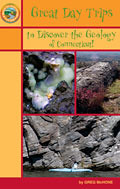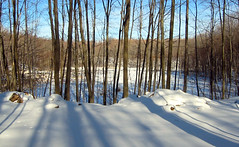Geo: Connecticut minerals at the Peabody
For anyone with even a passing interest in minerals, a trip to the mineral room at the Yale Peabody Museum in New Haven promises many surprises and treats.
The mineral room is one of my boys' favorite stops when we visit this wonderful museum (along with the collection of strong and sometimes foul odors to be sampled in the displays of animal musks and scents in an adjacent room), as we did yesterday.
Minerals are defined as inorganic chemical compounds with their own, distinctive crystalline structure, and that can be identified by their chemical composition, crystals and molecular arrangements. Rocks are usually composed of one or more minerals.
Many that seem ordinary under normal light can display remarkable colors when viewed under a different spectrum. Be sure to press the button to view examples in the case to the left as you enter the room.


Just past this display are cases containing Connecticut minerals. One includes a display of limestone and marbles, formed from minerals deposited in the mud of ancient seafloors as the shells of ancient marine animals. There are several from the state's northwest hills, including Diopside and Tremolite from Canaan.
Another case displays minerals associated with the ancient lava flows we recognize today as the traprock ridges of Connecticut's central valley. In it are specimens of Anhydrite, Aragonite, and Chalcocite from Meriden, and Amethyst and Calcite from East Haven. Copper ore is also associated with basalt, one of the primary types of rock associated with the traprock ridges, and there is a very large, 192-pound mass of copper also found in East Haven near the entry to the mineral room.
There is also a case dedicated to hydrothermal minerals. Most, including small deposits of gold, formed with heat supplied by ground water that rose from deep in the earth's crust. A spectacular specimen of Barite from Cheshire can be seen in the case in the entryway, labeled as number 10.
At the back of the mineral room is an astonishing collection of minerals, including a great many species known from Connecticut. Here are fine examples of pegmatites, igneous rocks characterized by large minerals, and that have been changed under the tremendous heat and pressure of metamorphism.
Many are from Branchville, a small Fairfield County locality (east of Ridgefield) where a great variety of minerals have been found, including Albite, Beryl, Columbite, Microcline, Muscovite, and Rose Quartz. Other Connecticut pegmatites on display include Lepidomelande and Quartz from Haddam. There is Ilmenite from Litchfield, Cordierite from Plymouth, Samarskite from South Glastonbury, and Stilbite from Thomaston.




















